
Dunoon is the main town on the Cowal Peninsula in the south of Argyll and Bute, west of Scotland. It is located on the western shore of the upper Firth of Clyde, to the south of the Holy Loch and to the north of Innellan. As well as forming part of the council area of Argyll and Bute, Dunoon also has its own community council. Dunoon was a burgh until 1976.

Loch Long is a body of water in the council area of Argyll and Bute, Scotland. The Sea Loch extends from the Firth of Clyde at its southwestern end. It measures approximately 20 miles in length, with a width of between one and two miles. The loch also has an arm, Loch Goil, on its western side.

The Cobbler is an 884 metres (2,900 ft) mountain located near the head of Loch Long in Argyll and Bute, Scotland. It is a Corbett, and is an important site for rock climbing in the Southern Highlands. Many maps include the name Ben Arthur, but the name The Cobbler is more widely used. In the 19th century it was referred to as The Cobbler and his Wife.
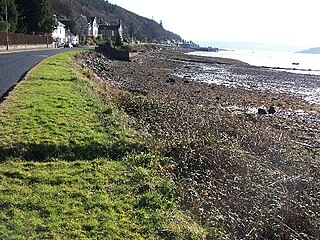
Kilmun is a linear settlement on the north shore of the Holy Loch, on the Cowal Peninsula in Argyll and Bute, Scottish Highlands. It takes its name from the 7th-century monastic community founded by an Irish monk, St Munn. The ruin of a 12th-century church still stands beside the Kilmun Parish Church and Argyll Mausoleum.

Strone is a village on the Cowal Peninsula, in Argyll and Bute in the Scottish Highlands at the point where the north shore of the Holy Loch becomes the west shore of the Firth of Clyde. The village lies within the Loch Lomond and The Trossachs National Park.
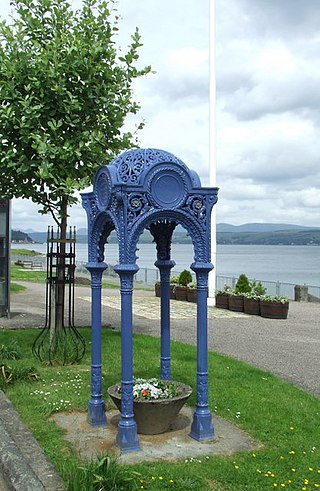
Kirn is a village on the Cowal Peninsula, in Argyll and Bute in the Scottish Highlands on the west shore of the Firth of Clyde on the Cowal peninsula. It now forms part of the continuous habitation between Dunoon and Hunters Quay, where the Holy Loch joins the Firth of Clyde. It originally had its own pier, with buildings designed by Harry Edward Clifford in 1895, and was a regular stop for the Clyde steamer services, bringing holidaymakers to the town, mostly from the Glasgow area.

Ardnadam is a village on the Holy Loch on the Cowal Peninsula, in Argyll and Bute, west of Scotland. It is located northwest of Hunters Quay and east of Sandbank, and sits across the loch from Kilmun.
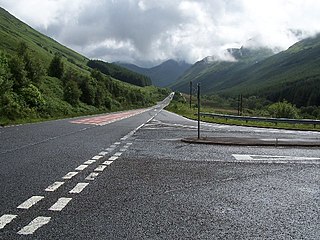
The A815 is a major road located on the Cowal peninsula, in Argyll and Bute, Scotland. It runs for about 35.7 miles (57.5 km) from the A83, near Cairndow, in the north to Toward in the south. It passes beside three lochs, while its final stretch is along the Firth of Clyde.

Hunters Quay is a village, on the Cowal Peninsula, in Argyll and Bute, Scottish Highlands. Situated between Kirn to the south and Ardnadam to the north, Hunters Quay is the main base of Western Ferries, operating between Hunters Quay and McInroy's Point.
Humphrey Ewing Crum-Ewing was a Scottish Liberal politician who sat in the House of Commons from 1857 to 1874.

Dunoon Castle is a ruined castle in Dunoon on the Cowal Peninsula, in Argyll and Bute, west of Scotland. The castle sat upon a cone-shaped hill about 80 feet (24 m) high. Very little remains of the castle's structure today. Castle House, built in 1822, stands a few yards north of the castle ruins.
Andrew Boyd, Bishop of Argyll (1567–1636) was a Scottish Protestant bishop and Latin poet.

Glen Lean, is a glen on the Cowal Peninsula, in Argyll and Bute, west of Scotland. It is a glacial-formed glen, with near vertical sides along part of the landform. It runs from the head of the Holy Loch in the east to the head of Loch Striven in the west. The only hamlet in the glen is Clachaig. The Little Eachaig River flows out of the glen, joining the River Eachaig and flows into the Holy Loch. The Tarsan Dam is the other notable feature in the glen.
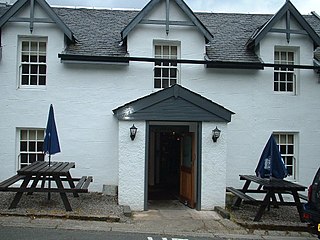
The Whistlefield Inn is a Category C listed building in Whistlefield, Argyll and Bute, Scotland, about twelve miles northwest of Dunoon. Built in 1663, it was originally a drover's inn on the route between Strachur and Ardentinny. It sits about 1,300 feet (400 m) from the eastern shores of Loch Eck. Today, it is an inn and restaurant.

High Kirk, also known as the Old Parish Church, is a Church of Scotland church building in Dunoon, Cowal, Argyll and Bute, Scotland. It is located on Kirk Street, just south of the town centre. Constructed in the Gothic revival style, it is a Category B listed building. After being scheduled for closure, the final service was held at the church on 1 October 2023.

The Queen's Hotel was a hotel located on Marine Parade in Kirn, Argyll and Bute, Scotland. Now a private residence, it is a Category C listed building, dating to around 1859. Its first proprietor was Mrs Urquhart.

Dunoon Pier is a Victorian pier in Dunoon, Cowal peninsula, Argyll and Bute, Scotland. It is owned by Argyll and Bute Council, and was completed in its current form in 1898. Reaching out into the Firth of Clyde, the earliest parts of the pier date to 1835. It is now a Category A listed structure and, according to Historic Environment Scotland, the best surviving example of a timber ferry pier in Scotland.
Invereck is a Category B listed building in Sandbank, near Dunoon, Argyll and Bute, Scotland. Dating to around 1886, it is located near the head of the Holy Loch.
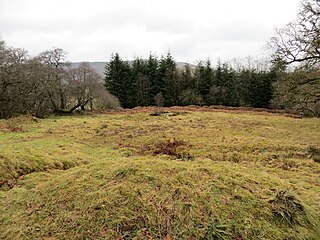
Ardnadam Farm is the site of an ancient cromlech in the village of Ardnadam, Argyll and Bute, Scotland. The relic was, according to popular tradition, the grave of a king who was named after Adam. Ardnadam Farm, located near Loch Loskin, was supposedly so-called in accordance with the tradition. The stones were later considered to be fragments of a Druidical altar.

McColl's Hotel was a hotel in Dunoon, Cowal, Argyll and Bute, Scotland. It stood, on Tom-a-Mhoid Road in the town's West Bay, adjacent to Castle Hill and the steamboat pier, between 1883 and 2015, when it was demolished. During its first century in operation, it was recognised as a desirable destination for tourists visiting the town, especially by steamboat. In 1910, it was listed in the World's Hotel Blue Book and Who's Who in the Hotel World, along with Dunoon's Argyll Hotel, Crown Hotel and Royal Hotel. While the Argyll was described as Dunoon's largest hotel, McColl's was noted as being its most select due to having its own grounds.


















